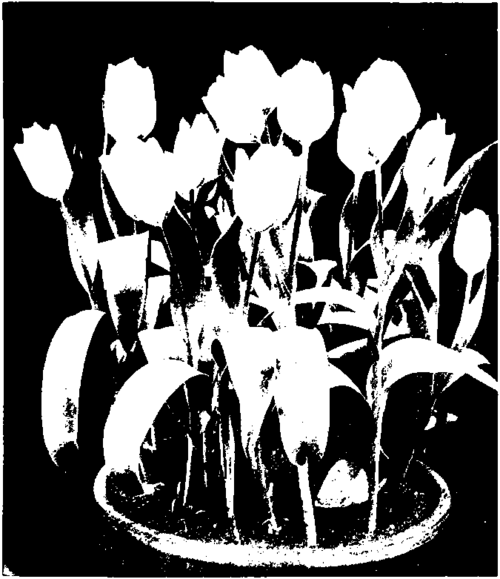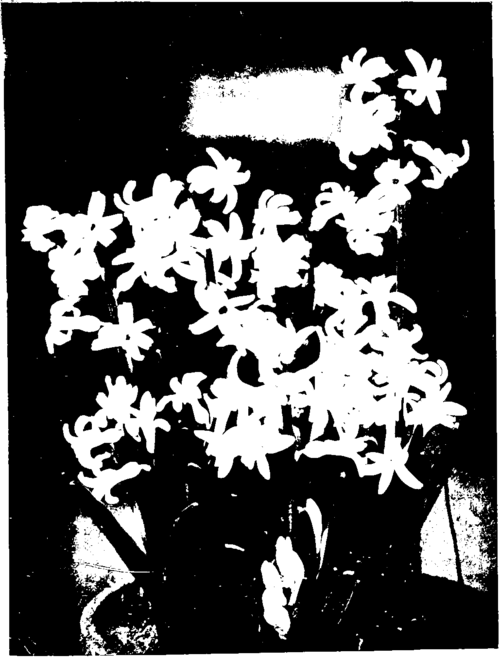XXXII. Bulbs For The Winter Window-Garden
Description
This section is from the book "Indoor Gardening", by Eben E. Rexford. Also available from Amazon: Indoor Gardening.
XXXII. Bulbs For The Winter Window-Garden
MANY a fl ower-lovinff woman who passes the shops of the florists in our great cities, along about holiday time, can not resist the temptation to pause before the windows in which Hyacinth and Tulip, Lily and Narcissus, vie with each other in making the place look like fairyland. Always the longing comes to possess a bit of this lavish display of beauty for the home. But the wish gives way to the thought that such beauty is not for the amateur florist. The growing of bulbs for winter flowering must be left to the professional florist. There is-there must be-a "knack" about it which the ordinary person can not hope to master.
Here is where a great mistake is made. There is no "knack" of any kind, using the term in the sense which means a mysterious process of cultivation which is-and must ever remain-a secret to all but the elect few. The fact is, there is nothing simpler in all flower-growing, than the cultivation of many kinds of bulbs in the house in winter. Indeed I know of no phase of floriculture in which the amateur gardener is more likely to be successful. All the " knack" there is about it consists in knowing what to do, and how to do it.
And this any child who loves flowers can easily learn.
Bulbs intended for winter-flowering should be ordered as early in the season as possible. Most of them are imported, and shipments will begin to arrive early in September. As soon as received the dealers will begin to fill the orders of their customers, if instructed to do so. All bulbs part with vitality rapidly when exposed to the air; therefore it is advisable to procure them as soon as possible after they are unpacked by the florists.
It is also quite important that they be potted as soon as possible after they are received from the florist. Therefore begin to get ready for taking proper care of them as soon as your order has been sent away, that there may be no unnecessary delay in getting them into pots on their arrival.

Early Tulips In Pot.
Success with bulbs depends largely on the soil you give them to grow in. Here is a formula for a compost that never fails to give perfect satisfaction: Ordinary garden-loam, one-third; old cow-manure, one third; sand, one-third; mix thoroughly.
This will give you a soil that is light, friable, and rich. It is admirably adapted to all bulbs whose culture can be advised for the window-garden.
It is quite important that the manure used be old and well-rotted. Fresh manure is always to be avoided. Indeed, rather than make use of it among bulbs, I would prefer to go without a fertilizer altogether. Manure that is black, and can be readily crumbled under the hoe, is in proper condition to use.
If barn-yard manure is not obtainable, substitute bone-meal, as advised in the chapter on The Use of Fertilizers. But so superior is the barnyard product that it is well worth making a special effort to secure it.
If new pots are to be used, do not fail to give them a good soaking before you fill them with soil. See that drainage is good, for no bulb likes to stand with its roots in the mud. If old pots are to be used, scald them well, and scrub them with strong soapsuds.
If you have never attempted the forcing of bulbs in winter, I would advise you to confine your selection for the first season to Hyacinths, Tulips, Narcissus, and the Bermuda Lily, more commonly known as the "Easter Lily," because it is so extensively forced for decorative purposes at Easter-time.
The above are not only the finest of all bulbs, so far as beauty is concerned, but they are surest to bloom, and will give excellent satisfaction under very ordinary treatment, if instructions are followed.
Of the Tulip, I would advise the early-flowering, single sorts. While not as showy, perhaps, as the double and later-flowering sorts, it is surer to bloom. In richness of color it is quite equal to any variety of this most extensive family.
Of the Hyacinths I would advise the single varieties of Holland growth, and the Romans. Double Holland Hyacinths will bloom quite as satisfactorily as the single kinds, but their flowers are so thickly set along the spike that they crowd each other until individuality seems lost. This, however, is simply a matter of taste, and as many persons prefer double to single flowers, they will be inclined to give preference to the kinds for which I have the least liking. They are really lovely flowers, only the single sorts, being smaller, and more loosely arranged along the stalk, are more graceful, and lack the formal appearance of the double varieties. Have some of each, and when they come into bloom you can make your choice between them.

Roman Hyacinths.
Roman Hyacinths are somewhat unlike the Holland type in general habit. They send up four, five, often six stalks of bloom from each bulb, while the others seldom have more than one. Their flowers are less in number, and very loosely arranged along the stalk, and consequently they never crowd each other, and the general effect is far more graceful. We have perhaps no plant that enjoys greater popularity during the holiday season. Pots and baskets of them, wrapped in fancy paper, and tied with lovely ribbons, will be seen in great quantities in the windows of the florists, tempting the passer-by to invest in one of the loveliest gifts of the season. Their fragrance is as delicious as their flowers are lovely. Pink, yellow, and blue varieties are advertised by the dealers, but none of these colors are good. The white variety is the only one I would advise the amateur to select.
Few persons would be likely to make use of the Holland Hyacinths in general decorative work, but the Roman is well adapted for this purpose, and is extensively used in cut-flower work because it combines so charmingly with other flowers.
The Holland Hyacinths come in a wide variety of rich and delicate colors. There are some superb shades of pink, and rose and soft blue, and the carmines, and reds, and purples are equal to the task of making the windows in which they grow quite as gay as any Geraniums can.
Fine as are the Tulip and the Hyacinth, the Narcissus must be given a more prominent place on the list. Few flowers are more beautiful. Under the name of Daffodil some varieties have been popular ever since the old poets began to make mention of flowers. Shakespeare speaks of them in most friendly terms, and tells us of the flower:
"That comes before the swallows dare and take The winds of march with beauty."
No window-garden can be considered complete if it does not include a few of the most prominent varieties. Among the best, for forcing, are:
Continue to:
- prev: XXXI. Some Good Decorative Plants
- Table of Contents
- next: XXXII. Bulbs For The Winter Window-Garden. Part 2
